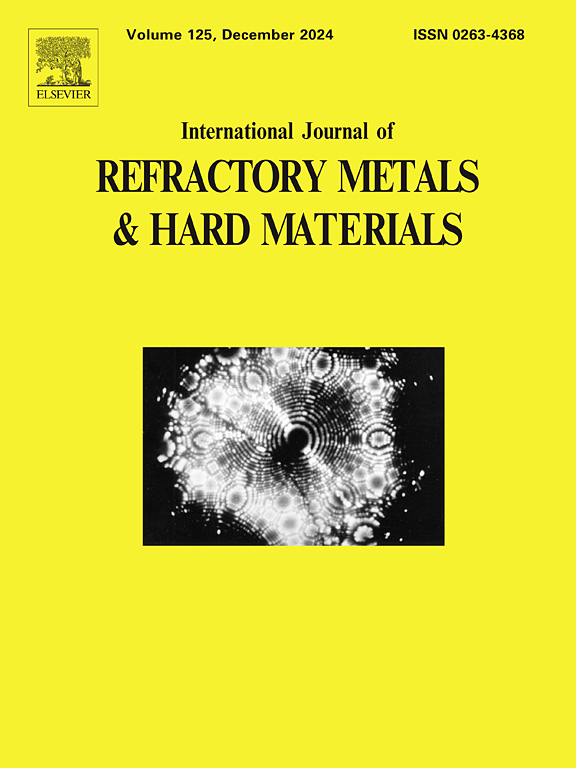用非调和统计矩法研究W高压熔炼过程中空位效应的新见解
IF 4.2
2区 材料科学
Q2 MATERIALS SCIENCE, MULTIDISCIPLINARY
International Journal of Refractory Metals & Hard Materials
Pub Date : 2024-11-20
DOI:10.1016/j.ijrmhm.2024.106962
引用次数: 0
摘要
钨是一种普遍存在的难熔金属,具有许多潜在的应用前景,但其高压熔融行为仍存在争议。一些物理学家建议,这个问题可以通过考虑空位的贡献来解决。然而,由于缺乏关于恶劣环境中晶体缺陷的信息,他们的想法尚未得到证实。本文对统计矩法进行了改进,阐明了空位的形成和对钨熔化性能的影响。我们的非调和计算表明,众所周知的Arrhenius定律无法模拟等压加热过程中空位的扩散。此外,如果忽略等温挤压过程中外部功的贡献,空位形成的吉布斯能将被严重低估。在仔细研究了温度和压力的影响后,我们得出结论,W的平衡空位浓度沿固液边界急剧下降。因此,Gorecki准则不能用于描述w的熔化现象。我们还证明了Errandonea的空位介导的熔化模型不适用于解释金刚石砧槽测量中异常低熔化信号的出现。为了解决实验结果与计算结果之间的差异,应充分考虑W样品的碳污染。最后,我们回顾了Hung等人的空位校正技术,发现它只降低了熔化温度几个百分点。这些证据表明,在研究W在极端条件下的熔化过程时,可以完全忽略空位的影响。本文章由计算机程序翻译,如有差异,请以英文原文为准。
Novel insights into vacancy effects on high-pressure melting of W from anharmonic statistical moment method
W is a ubiquitous refractory metal with numerous potential applications, but its high-pressure melting behaviors remain controversial. Some physicists suggest that the problem may be addressed by including the contribution of vacancies. However, their ideas stay unverified due to the lack of information about crystallographic defects in harsh environments. Herein, the statistical moment method is enhanced to illuminate how vacancies form and impact the melting properties of W. Our anharmonic calculations indicate that the well-known Arrhenius law fails to model the proliferation of vacancies during isobaric heating. Besides, the Gibbs energy of vacancy formation will be severely underestimated if the contribution of external work is neglected during isothermal squeezing. After scrutinizing both temperature and pressure effects, we conclude that the equilibrium vacancy concentration of W drops dramatically along the solid-liquid boundary. Therefore, the Gorecki criterion cannot be applied to describe the melting phenomenon of W. We also demonstrate that the vacancy-mediated melting model of Errandonea is inappropriate for explaining the emergence of abnormally low melting signals in diamond-anvil-cell measurements. Instead, the carbon contamination of W samples should be thoroughly considered to resolve the discrepancy between experimental and computational results. Finally, we revisit the vacancy correction technique of Hung et al. and find that it only depresses the melting temperature by a few percent. The listed pieces of evidence show that the influences of vacancies can be safely ignored when investigating the melting process of W under extreme conditions.
求助全文
通过发布文献求助,成功后即可免费获取论文全文。
去求助
来源期刊
CiteScore
7.00
自引率
13.90%
发文量
236
审稿时长
35 days
期刊介绍:
The International Journal of Refractory Metals and Hard Materials (IJRMHM) publishes original research articles concerned with all aspects of refractory metals and hard materials. Refractory metals are defined as metals with melting points higher than 1800 °C. These are tungsten, molybdenum, chromium, tantalum, niobium, hafnium, and rhenium, as well as many compounds and alloys based thereupon. Hard materials that are included in the scope of this journal are defined as materials with hardness values higher than 1000 kg/mm2, primarily intended for applications as manufacturing tools or wear resistant components in mechanical systems. Thus they encompass carbides, nitrides and borides of metals, and related compounds. A special focus of this journal is put on the family of hardmetals, which is also known as cemented tungsten carbide, and cermets which are based on titanium carbide and carbonitrides with or without a metal binder. Ceramics and superhard materials including diamond and cubic boron nitride may also be accepted provided the subject material is presented as hard materials as defined above.

 求助内容:
求助内容: 应助结果提醒方式:
应助结果提醒方式:


